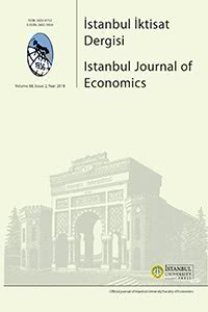* YENİ SANAYİLEŞEN ÜLKELERDE AR-GE HARCAMALARI VE YÜKSEK TEKNOLOJİ ÜRÜNÜ İHRACATI ARASINDAKİ İLİŞKİNİN PANEL VERİ ANALİZİ YÖNTEMİ İLE İNCELENMESİ
Bu çalışmada, Ar-Ge harcamalarının yüksek teknoloji ürünü ihracatına etkisi 7 yeni sanayileşen ülkenin 1996-2013 dönemi verilerine panel veri analiz yöntemlerinden Granger nedensellik ve sabit ve rassal etkiler tah- min metotları uygulanılarak analiz edilmiştir. Çalışmada, Dünya Bankası tarafından yüksek teknoloji ürünü olarak kabul edilen 5 sektörün verileri kullanılmıştır. Granger nedensellik testi sonucuna göre Ar-Ge harcamaları yüksek teknoloji ürünü ihracatına neden olurken, rassal etkiler tahmin so- nuçları da Ar-Ge harcamalarının yüksek teknoloji ürünü ihracatına pozitif ve anlamlı etki ettiğini göstermiştir.
Anahtar Kelimeler:
Yeni Sanayileşen Ülkeler, Ar-Ge Harcamaları, Yüksek Teknoloji İhracatı, Panel Veri Analizi
INVESTIGATION OF THE RELATIONSHIP BETWEEN AR-GE PAYMENTS AND HIGH TECHNOLOGY EXPORTS IN NEW INDUSTRIAL COUNTRIES BY PANEL DATA ANALYSIS METHOD
This study examines the impact of research and development (R&D) expenditures on high technology exports from 7 Newly Industrialized Countries during the period 1996-2013 by using panel data analysis. The data for high technology exports are used from 5 different manufacturing sectors, which are accepted by the World Bank. We found that R&D expenditures had positive impact on high technology exports. Moreover, there was one-way causality relationship running from R&D expenditures to high technology exports.
___
- Baltagi. B.H., (2005), Econometrics Analysis of Panel Data, 3. Baskı, Chichester: John Wiley & Sons
- Belay, S., (2005), “Determinants of Levels of High Technology Exports: An Empirical Investigation”, Advances in Competitiveness Research, 13(1), 64-79
- Braunerhjelm, P. ve Thulin, P., (2006), “Can Countries Create Comparative Advantages?”, Centre of Excellence for Studies in Science and Innovation (CESIS), Electronic Working Paper Series, Working Paper No. 61
- Göçer, İ., (2013), “Ar-Ge Harcamalarının Yüksek Teknolojili Ürün İhracatı, Dış Ticaret Dengesi ve Ekonomik Büyüme Üzerindeki Etkileri”, Maliye Dergisi, 165, 215-240
- Granger, C.W.J., (1969), “Investigating Causal Relations by Econometric Models and Cross-spectral Methods”, Econometrica, 37(3), 424-438
- Grossman, G. ve Helpman, E., (1991), “Innovation and Growth in World Economy”, Cambridge: MIT Press
- Hatzichronoglou, T., (1997), “Revision of the High-Technology Sector and Product Classification”, OECD Science, Technology and Industry Working Papers, 1997/02, OECD Publishing.
- Hausman, J.A., (1978), “Specification Tests in Econometrics”, Econometrica, 46, 1251-1272.
- Hsiao, C., (2003), Analysis of Panel Data, Cambridge: Cambridge University Press
- İsmail, N.W., (2013), “Innovation and High-Tech Trade in Asian Countries”, International Conference on Recent Developments in Asian Trade Policy and Integration, 20–21 February 2013, Kuala Lumpur, Malezya
- Kılıç, C., Bayar, Y. ve Özekicioğlu, H., (2014), “Araştırma Geliştirme Harcamalarının Yüksek teknoloji Ürün İhracatı Üzerindeki Etkisi: G-8 Ülkeleri İçin Bir Panel Veri Analizi”,Erciyes Üniversitesi İktisadi ve İdari Bilimler Fakültesi Dergisi, 44, 115-130
- Knoema, (2016), Research and Development Expenditure (% of GDP), http://knoema.com/WBWDIGDF2016Mar/world-development- indicators-wdi-february-2016#, (erişim: 2016)
- Lall S., (2000), “The Technological Structure and Performance of Developing Country Manufactured Exports, 1985-98”, Oxford Development Studies, 28, 337-369
- Landesmann, M. ve Pfaffermayr, M., (1997), “Technological Competition and Trade Performance”, Applied Economics, 29(2), 179-196
- Mayer, J., Butkevicius, A. ve Kadri, A. (2002), “Dynamic Products in World Exports”, Geneva, UNCTAD, Discussion Papers No. 159
- OECD, (2009), “OECD Science, Technology and Industry Scoreboard 2009”, http://www.oecd-ilibrary.org/sites/sti_scoreboard-2009- en/03/02/, (erişim: 2016)
- Özer, M. ve Çiftçi, N., (2009), “Ar-Ge Harcamaları ve İhracat İlişkisi: OECD Ülkeleri Panel Veri Analizi”, Dumlupınar Üniversitesi Sosyal Bilimler Dergisi, 23, 39-49
- Posner, M.V., (1961), “International Trade and Technical Progress”, Oxford Economic Papers, 13, 323-341
- Rivera-Batiz, L.A. ve Romer, P.M., (1991), “Economic Integration and Endogenous Growth”,Quarterly Journal of Economics, 106, 531-555
- Sandu, S. ve Ciocanel, B., (2014), Impact of R&D and Innovation on High-tech Export”, Procedia Economics and Finance, 15, 80-90
- Srholec, M., (2006), Global Production Systems and Technological Catching - Up: Thinking Twice about High-Tech Industries in Emerging Countries. In K. Piech and S. Radoˇseviˇc (eds.), The Knowledge-Based Economy in Central and East European Countries: Countries and Industries in a Process of Change. New York: Palgrave Macmillan
- Srholec, M., (2007), “High-Tech Exports from Developing Countries: A Symptom of Technology Spurts or Statistical Illusion?”, Review of World Economics 143(2), 227-255
- Vernon, R. (1966), “International Investment and International Trade in the Product Cycle”, Quarterly Journal of Economics, 80, 190-207
- Verspagen, B. ve Wakelin, K., (1997), “Trade and Technology from a Schumpeterian Perspective”, International Review of Applied Economics, 11(2), 181-194
- World Bank, (2016), “High-technology Exports (Current US$)”, http:// data.worldbank.org/indicator/TX.VAL.TECH.CD, (erişim: 2016)
- World Bank, (2016), “Research and Development Expenditure (% of GDP)”, http://data.worldbank.org/indicator/GB.XPD.RSDV.GD.ZS, (erişim: 2016)
- Young, A., 1991, “Learning by Doing and the Dynamic Effects of International Trade”, Quarterly Journal of Economics, 106, 369-405
- ISSN: 2602-4152
- Yayın Aralığı: Yılda 2 Sayı
- Başlangıç: 1939
- Yayıncı: İstanbul Üniversitesi
